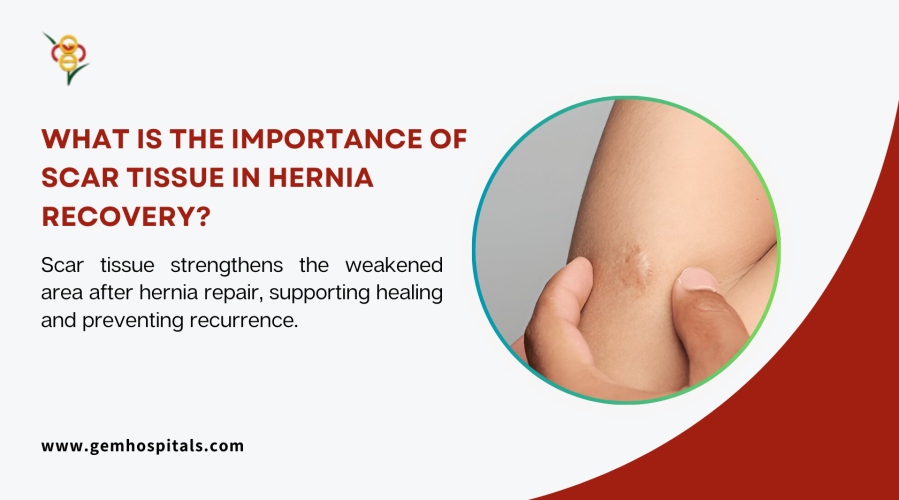Learn why street foods can increase the risk of esophageal and gastric issues. Understand contamination, hygiene lapses, and safety tips to protect your digestive health.
What is the importance of scar tissue in hernia recovery?

Healing from a hernia surgery goes beyond waiting for the incision to heal; the body has to create new and stronger scar tissue to strengthen the area of weakness. This scar tissue has an important role to play in the durability of the hernia repair and in minimizing the risk of a further recurrence at the site. In this article, we will go deeper into the details on how scar tissue plays a part in hernia healing process, why it is crucial and some tips on how to enhance the formation of healthy scar tissue during the healing process.
Understanding Scar Tissue in Hernia Repair
This is a type of tissue that develops in the body as a result of an injury that has healed. The body immediately reacts to an injury, a cut made during surgery or a tear by sending collagen, a protein that is used to seal the area. This collagen is arranged in thick fibrous tissue called scar tissue which aids in the healing process of the wound by closing the area of injury. Scar tissue is not as elastic or strong as normal tissue but it is helpful for creating a stable base over the area that has been compromised.
In hernia repair particularly, the formation of scar tissue is important since this is what contributes to the strengthening of the area of weakness. The tissue that is formed after the surgery of hernia repair is slightly different from the normal tissue of the body since it is mainly composed of densely packed collagen fibers. This gives it a stronger but more rigid structure that is well suited to reinforcement of surgical sutures especially in areas where there has been a herniation.
The Role of Scar Tissue in Strengthening the Hernia Repair
While scar tissue formation in hernia repair is desirable and necessary, it may also be complicated. When the surgeon closes the hernia, a part of the body is left with an opening that has to be strengthened to bear the everyday stresses and strains. Tissue remodeling is a process, which starts after surgery and the body tries to knit the affected area by developing new fibers that span across the repair site. Scar tissue that has been formed replaces the damaged tissue as a natural graft and offers the repaired area strength and sturdiness.
As days go by, the scar tissue developed becomes part of the surgical repair of the hernia. Being attached to the original tissue it relieves pressure on the hernia repair site and makes it stronger to withstand pressure from the act of bending or lifting or even sneezing. If there was inadequate formation of the scar tissue then the area that was operated on could still be at risk and thus increase the likelihood of getting another hernia in that particular area.
Types of Scar Tissue and Their Impact on Hernia Repair
- Normal Scar Tissue: It is a thin fibrous layer over the wound to strengthen the area that has healed and still allow movement and little or no pain.
- Hypertrophic Scars: Flat and wide, keloid scars are stronger than regular ones, do not cross the wound line, and can be painful and may need medical attention.
- Keloid Scars: Fibrous tissue that forms outside the wound and can be raised, thick and tough; not common in hernia surgery but may require treatment if causing lumps or pain.
- Adhesions: Fibrous structures that join tissues or organs together, often seen after operations involving the abdomen, and may cause restricted movement or dysfunction of the affected part; may require surgical intervention if problems develop.
Benefits of Scar Tissue in Reducing Hernia Recurrence
- Strengthens the Hernia Repair Site: It brings scar tissue which helps to strengthen the previously damaged area to support minor daily stress and strains.
- Reduces the Risk of Hernia Recurrence: Thick scar tissue makes it impossible for the area to be opened up again thus reducing the likelihood of the hernia recurring.
- Promotes Long-Term Stability: Fibrous tissue forms a strong layer, which supports the hernia repair process and let patients go about their daily activities with minimal risk of recurrence of the problem.
- Aids in Faster Functional Recovery: Organized scar tissue allows the patients to regain normal abdominal wall contour, decreased pain and improved overall healing time.
Tips for Supporting Healthy Scar Tissue Formation
Healthy scar tissue development is critical to achieving a non-problematic and long-term hernia repair. Here are some tips to support your body’s natural healing process and encourage the development of resilient scar tissue:
- Follow Post-Surgery Instructions: Follow your surgeon’s instructions on how to stay physically inactive, avoid straining, and how to treat the wound. These instructions are meant to help facilitate healing and minimize the risk of certain complications that may interfere with scarring.
- Maintain a Balanced Diet: The food is essential in the recovery process and a diet that comprises of protein, vitamin C, vitamin E and zinc will help in the synthesis of collagen which is used in the formation of scar tissue. Lean meats, fish and legumes are sources of protein that will help your body build collagen and other tissues while vitamins C and E together with zinc help with tissue repair and inflammation moderation.
- Avoid Excessive Strain on the Repair Site: Do not engage in any strenuous activities for the first few weeks after surgery because excessive pressure on the area may hinder the formation of scar tissue. Light exercise is often recommended, but you should always check with your surgeon before engaging in any physical activities.
- Stay Hydrated: Tissue health and the healing process of the body require sufficient intake of water. Daily intake of water helps in keeping the skin and tissues elastic which is vital in scar formation.
- Scar Massage (if recommended): Occasionally, your doctor may suggest that you begin scar massage after some weeks in order to make the tissue more pliable and easily blend with other tissues. Scar massage may be beneficial in preparing the tissue and releasing any of the strands that may have formed a bond but it should not be done without consulting a doctor to avoid straining the repair area.
- Consider Physical Therapy: Some patients that have been treated for hernia can benefit from physical therapy in building muscle strength and improving their mobility. It is always recommended that physical therapists provide exercises that will promote tissue healing and put minimal stress on the repaired area, which in the end will help in formation of healthier scar tissues.
The following steps will help create a good scar tissue and will help the body to heal well after the hernia repair surgery.
Fibrous scar tissue is vital for hernia repair because it contributes to the strength of the area that has been repaired and minimizes the possibility of a recurrence. Knowledge about it may enable the patient to embrace the body healing process and thus improve on the decision making process that they make regarding their body after surgery. By following some of the recommendations for enhancing healthy scarring, the patient can aid the body’s healing process and end up with a stronger tissue repair.
For more information regarding hernia recovery and treatment, go to GEM Hospital and schedule an appointment with our experts. It is therefore important to take early actions in your care to facilitate a good recovery and long term outcome.
Blogs & Article
Learn how to protect your colon during the monsoon by avoiding contaminated food and water. Get essential hygiene, diet, and safety tips to prevent infections.
Discover how poor monsoon hygiene increases gut infections, weakens digestion, and leads to long-term health risks. Learn prevention tips for a healthier monsoon.


